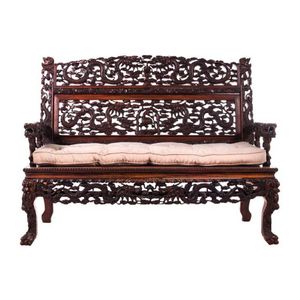1882 Australian Blackwood Buttoned Leather Mayoral Chair
You must be a subscriber, and be logged in to view price and dealer details.
Subscribe Now to view actual auction price for this item
When you subscribe, you have the option of setting the currency in which to display prices to $Au, $US, $NZ or Stg.
- Circa - A Latin term meaning 'about', often used in the antique trade to give an approximate date for the piece, usually considered to be five years on either side of the circa year. Thus, circa 1900 means the piece was made about 1900, probably between 1895 and 1905. The expression is sometimes abbreviated to c.1900.
- Acanthus - A stylized leaf motif, one of the primary decorative elements of classical Greek and Roman architecture, derived from the genus of flowering plants in the family Acanthaceae, native to tropical and subtropical regions of the Mediterranean area. It is a common element in classical Greek and Roman design, and is often seen in Corinthian and Composite order columns and used as a decorative element in English, European and Australian furniture, particularly on the curve of a leg, and as decoration for a corbel.
- Blackwood - One of the best known and most widely used Australian timbers, blackwood (acacia melanoxylon), is a member of the Acacia (wattle) family and grows in eastern Australia from about Adelaide in South Australia, as far north as Cairns in Queensland.
The largest, straightest and tallest trees come from the wet forest and swamps of north-west Tasmania where it is grown commercially.
Blackwood timber colours range across a wide spectrum, from a very pale honey colour through to a dark chocolate with streaks of red tinge.
The hardwood timber has been commonly used in the production of furniture, flooring, and musical instruments in Australia from the late 19th century. However, the straight grain timber is not the most prized or valuable, that honour falls to blackwood with a wavy, fiddleback pattern, which is used both in the solid and as a veneer. Fiddleback was only used on the finest examples of furniture.
This item has been included into following indexes:
Visually similar items

A set of twelve Renaissance style oak dining chairs, late 19th century, including two carvers, the carvers 124 cm high, 62 cm wide, the chairs 111 cm high, 48 cm wide

A William IV mahogany spoon-back elbow chair, with turned and decorated front legs, studded green leather button backed upholstery with loose cushion, on casters.

A Chinese rosewood and mother-of-pearl inlaid carver, Qing Dynasty, late 19th to early 20th century, profusely pierced and inlaid throughout, having a shaped square back with an inlaid dragon plaque surrounded by pierced dragon and phoenix designs, a 'Thre

A Chinese export ware settee & matching armchair late Qing Dynasty (1644-1912), late 19th century, each heavily carved and pierced with dragon & cloud motifs, flanked by dragon head armrests
